
La Sagrada Familia (Joseph, Mary, and the baby Jesus, the Holy Family) forms the portion of the nacimiento (manger scene) known in Mexico as el misterio (the mystery).
Christmas is nearly upon us and it's time for the tianguis navideños, the annual month-long outdoor Christmas markets. These markets sell every kind of Christmas decoration, the sacred and the profane. A couple of weeks ago, I visited the Christmas market in Guadalajara. Last Sunday, I spent a few hours in its counterpart in Morelia. There are tianguis navideños in every Mexican town of any size, and if the town where you are doesn't have one, just peek into the doorway of any papelería (paper goods store). You're sure to see a big assortment of Christmas decoration.
The markets are open just in time for you to fill all of your holiday decorating and shopping needs. The truth is that visiting one of these eye-popping markets will undoubtedly create new needs that you never thought you had, for Christmas items that you never knew existed.
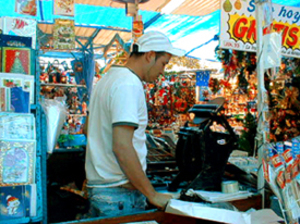
Aldo Gómez Martínez prints your calendars and Christmas cards while you shop for decorations. He's at the tianguis navideño twelve hours a day.
What's your pleasure? Pocket-size plastic calendars printed while-you-wait with holiday wishes and your name? A new stable for your manger scene? One new miniature light bulb, installed in last year's string of 100 that just won't light? Tree ornaments (from the simplest sphere to the most elaborate electronically-operated, musically revolving new bobble), tinsel, gift wrap, ribbons—you name it and it's available. That list of items is just the beginning: wait till you see Christmas decor, Guadalajara style.
My partner Judy and I decided to make a tour of a very popular Guadalajara Christmas market—my particular favorite—just so that I could give you the lowdown on what's out there for you this year. This tianguis will make your head spin with the variety it offers.
The downtown Guadalajara market, located in the tiny San José plaza on Avenida Alcalde just a few blocks north of the Cathedral, is packed with nearly 100 Christmas-décor-only vendors. The amount of available merchandise is a little overwhelming, but the market is compact and easy to navigate. It's open from early November until Christmas, from 9 AM until 9 PM seven days a week.
When we arrived, Judy reminded me, "We need papel roca, those big, water-colored sheets of paper to crumple and form into the shape of stones for the backdrop of the nacimiento, and we need both kinds of moss—heno (Spanish moss) and musgo (sheets of flat green moss)." I nodded eagerly, thinking that shopping in this Christmas market has about as much to do with need as shopping in your favorite candy store. We quickly found a booth with hand-painted papel roca and purchased several sheets.
We also found another paper for a nativity scene's background. It was painted deep blue and decorated with a silver-glittered Star of Bethlehem, a silhouette of palm trees and the Three Wise Men (Los Reyes Magos), so we bought that as well. Fortunately there is only so much of this wonderful paper that one can use—the temptation to keep buying more of it is great. At the bottom of the photo, you can also see heno (on the left) and musgo (on the right), ready to purchase and take home.
As we were buying a kilo of heno, I showed Judy the small bags of colored aserrín (sawdust)—blue, green, dark brown and natural—heaped up on one side of the booth. "That sawdust is for making the desert floor, rivers and lakes, mountains, and all the other natural geography of the nacimiento," I said, selecting several bags for this year's display.
Next we stopped at a stall selling only little wooden lean-tos ranging in size from shoebox to doghouse. "What in the world are these for?" Judy asked me. I smiled. "These chozitas (little huts) are the shelters for Mary, Joseph, and the baby Jesus. They're meant to house the main focus of a nacimiento. That particular section of the nacimiento is called el misterio (the mystery)." We both admired the cunning wooden structures, many with thatched or mossy roofs, fenced corrals, and other homey rustic touches.
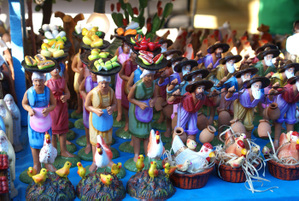
Click on each of the pictures to enlarge them so that you can enjoy all the details. They're no more than four inches tall and are made of clay, then hand painted. Look at the ladies on the left side of this picture: each one is wearing tiny glasses made of metal wire!
In the booth next to the casitas we found doll-size striped fabric tents. "And these little tents? What are these for?" Judy asked me. I held one, striped in blue and white, to admire it. "These are some of my very favorite things at the market. They're tents, just what you thought, and they're meant to be in the nacimiento as shelter for the people who live in the desert, the nomads. Lots of times in a nacimiento you'll see small figures of people as they go about their daily life placed in or around these tents. You know, the manger scene as it's built in Mexico shows much, much more than just the Holy Family. It incorporates all of life and its history, traditions and myths. Every important Biblical scene from the Garden of Eden to the Resurrection is included as well."
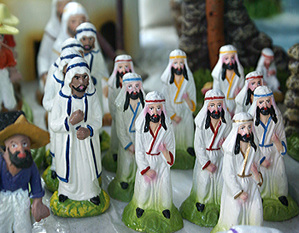
Here's a flock of three-inch high shepherds (handmade of clay), ready for placement in your nacimiento.
A booth filled with silk flowers, baskets, and ribbons diverted our attention from our quest for adornos navideños (Christmas decorations). The hundreds of hanging bolts of multicolored ribbons make the stands look like madcap Maypoles. Flowers are sold by the stem; baskets are sold individually; ribbons (plain or with flexible wired edges) are sold by the meter. Buy as much or as little as you want. Almost anyone can work artistic wonders with these gorgeous supplies, a pair of scissors, and a glue gun.

These baby chicks (handmade of clay) are no more than half an inch high. Compare them with the size of the Niño Dios (Baby Jesus) just to their right. Scale of sizes isn't particularly important in a nacimiento.
Again, our attention was drawn away by booth after booth filled with hundreds of sets of Christmas lights. We found everything from simple strands of tiny clear lights to lights in the shape of stars, flowers, and cartoon characters. Some of the light sets have tinkling electronic music built in; others (more to my liking) keep quiet. In the corners of many of the light filled booths, we found young people repairing (imagine that!) older strings of lights. Replacement bulbs (all sizes from the tiniest right on up to the largest) are available, and if replacing a bulb doesn't fix your string of lights, hand it over to the young man or woman and in a few minutes your problem will be solved.
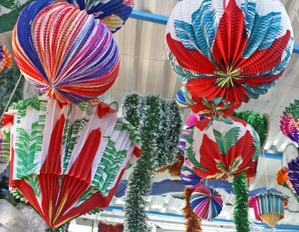
Some of Judy's favorite booths were the ones specializing in farolitos, the traditional folded paper light covers made especially for the Christmas season. Japanese paper lanterns with a Mexican twist, these look fantastic strung across a patio, festooning the front of a house, or hung individually in the garden. For mere centavos you can create a beautiful and traditional effect for your home.
Our arms were tiring as we carried our numerous purchases, but we had yet to look at nacimiento figures. Fortunately the car was parked just around the corner in a public parking lot, so we took a few minutes to stow our bags and have a quick soft drink in the ice cream shop just across Alcalde from the market. And then-onward and upward, we were back to the stalls!
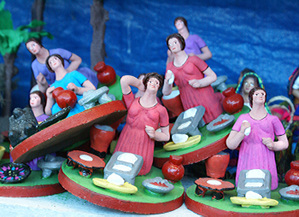
Typically Mexican: clay nacimiento figures of women making masa and tortillas.
Naturally, part of every Mexican Christmas market is devoted to the sales of figures for the nacimiento. Many families add to their collections of nacimiento figures year after year and generation after generation. Shopping for new figures can also be part of a family's traditions. Judy and I exclaimed over hundreds of wee people and animals, but my special favorites are the tiny representations of daily life in Mexico that mingle with the figures from Biblical times. A campesino with his burro, a woman in typical indigenous clothing cooking tortillas on a comal, an entire meat market complete with pig's head, sausages, and other meats hung on a wire above the counter, and row upon row of other hand-painted figures depict familiar activities.

The devil is always present in a Mexican manger scene. These devils carry bags of filthy lucre and bottles of tequila.
It's possible to find figures in sizes ranging from 1/2" tall to nearly life size. Biblical figures are an important part of the nacimiento. We found figures representing not only Mary, Joseph, and the Baby Jesus but also tiny kings, shepherds, animals, and entire hosts of angels. Old Testament figures (Adam and Eve and the serpent, Abraham and Isaac), New Testament figures (the woman at the well, the Crucifixion), and figures of pure legend (the hermit in the desert, a devil at the cave) all have their part in the Christmas story. In Mexico, the devil always appears prominently in a nacimiento as a reminder that even though Jesus came into the world, Satan still lurks close at hand. We bought a few figures, sighed longingly over many, and decided that we would just have to make the supreme sacrifice and plan to come back next year.

El Niño Dios comes in every size and is always the most important figure in a nacimiento. These range from about six inches to about the size of a two-year-old child. Beginning in early December, figures are placed in a family's nacimiento, but the baby Jesus is never laid in the manger until late on Christmas Eve.
As we meandered toward the street Judy kept stopping and touching and exclaiming over items we'd bypassed earlier. Although most Christmas decorations other than the nacimiento are relatively new to the Mexican experience, even Santa Claus and Rudolph are beginning to appear in the markets. Shooting stars made of cardboard and silver glitter, golden bells, box after box of Christmas tree ornaments, artificial Christmas trees in every size and artificial evergreen garlands called out to us as we walked. Six-inch-high palm trees for the desert! A camel as big as a dog! A snow globe that plays Ave Maria! Tiny clay Africans complete with loincloths, masks and spears! Shepherds! Shepherds! Shepherds! So much to see, so much to want, so much to buy!
Finally I said to Judy, "Repeat after me: There's always next year. There's always next year.
"Looking for a tailored-to-your-interests specialized tour in Mexico? Click here: Tours.
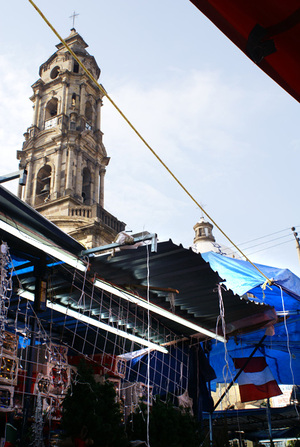

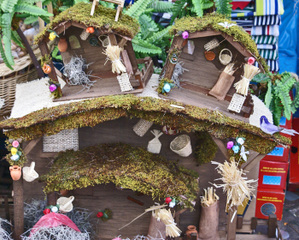
Leave a Reply